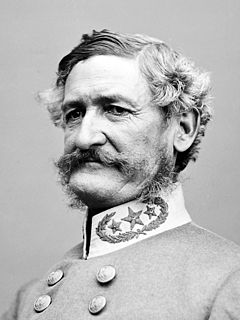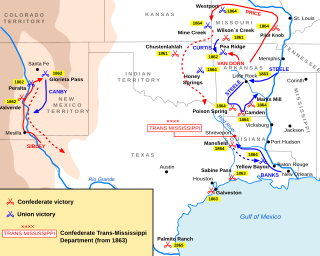
In the context of the American Civil War (1861–65), the border states were slave states that did not declare a secession from the Union and did not join the Confederacy. To their north they bordered free states of the Union and to their south they bordered Confederate slave states. Of the 34 U.S. states in 1861, nineteen were free states and fifteen were slave states. Two slave states never declared a secession or adopted an ordinance: Delaware and Maryland. Four others did not declare secession until after the Battle of Fort Sumter and were briefly considered to be border states: Arkansas, North Carolina, Tennessee and Virginia—after this, they were less frequently called "border states". Also included as a border state during the war is West Virginia, which was formed from 50 counties of Virginia and became a new state in the Union in 1863.

The Territory of New Mexico was an organized incorporated territory of the United States that existed from September 9, 1850, until January 6, 1912, when the remaining extent of the territory was admitted to the Union as the State of New Mexico, making it the longest-lived organized incorporated territory of the United States, lasting approximately 62 years.

The Territory of Arizona was a territory of the United States that existed from February 24, 1863 until February 14, 1912, when the remaining extent of the territory was admitted to the Union as the state of Arizona. It was created from the western half of the New Mexico Territory during the American Civil War.

Henry Hopkins Sibley was a career officer in the United States Army, who commanded a Confederate cavalry brigade in the Civil War.

The New Mexico Campaign was a military operation of the Trans-Mississippi Theater of the American Civil War from February to April 1862 in which Confederate Brigadier General Henry Hopkins Sibley invaded the northern New Mexico Territory in an attempt to gain control of the Southwest, including the gold fields of Colorado and the ports of California. Historians regard this campaign as the most ambitious Confederate attempt to establish control of the American West and to open an additional theater in the war. It was an important campaign in the war's Trans-Mississippi Theater, and one of the major events in the history of the New Mexico Territory in the American Civil War.

The First Battle of Mesilla, was fought on July 25, 1861 at Mesilla in New Mexico Territory, in present-day Doña Ana County, New Mexico.

John Austin Wharton was a lawyer, plantation owner, and Confederate general during the American Civil War. He is considered one of the Confederacy's best tactical cavalry commanders.

John Gregg was an American politician who served as a Deputy from Texas to the Provisional Congress of the Confederate States from 1861 to 1862. He served as a senior officer of the Confederate States Army and was killed in action during the Siege of Petersburg.

The Trans-Mississippi Theater of the American Civil War consists of the major military operations west of the Mississippi River. The area is often thought of as excluding the states and territories bordering the Pacific Ocean, which formed the Pacific Coast Theater of the American Civil War (1861-1865).

The U.S. state of Texas declared its secession from the United States of America on February 1, 1861, and joined the Confederate States on March 2, 1861, after it replaced its governor, Sam Houston, when he refused to take an oath of allegiance to the Confederacy. As with those of other States, the Declaration was not recognized by the United States government at Washington. Some Texan military units fought in the Civil War east of the Mississippi River, but Texas was most useful for supplying soldiers and horses for Confederate forces. Texas' supply role lasted until mid-1863, after which time Union gunboats controlled the Mississippi River, making large transfers of men, horses or cattle impossible. Some cotton was sold in Mexico, but most of the crop became useless because of the Union naval blockade of Galveston, Houston, and other ports.

The New Mexico Territory, which included the areas which became the modern U.S. states of New Mexico and Arizona as well as the southern part of present-day Nevada, played a small but significant role in the Trans-Mississippi Theater of the American Civil War. Despite its remoteness from the major battlefields of the east and its existence on the still sparsely populated and largely undeveloped American frontier, both Confederate and Union governments claimed ownership over the territory, and several important battles and military operations took place in the region.
Marcus H. MacWillie was a politician who represented the Confederate Arizona Territory in the Congress of the Confederate States during the American Civil War.

The First Battle of Dragoon Springs was a minor skirmish between a small troop of Confederate dragoons of Governor John R. Baylor's Arizona Rangers, and a band of Apache warriors during the American Civil War. It was fought on May 5, 1862, near the present-day town of Benson, Arizona, in Confederate Arizona.

Prior to the adoption of its name for a U.S. state, Arizona was traditionally defined as the region south of the Gila River to the present-day Mexican border, and between the Colorado River and the Rio Grande. It encompasses present-day Southern Arizona and the New Mexico Bootheel plus adjacent parts of Southwestern New Mexico. This area was transferred from Mexico to the United States in the Gadsden Purchase of 1853. Mining and ranching were the primary occupations of traditional Arizona's inhabitants, though growing citrus fruits had long been occurring in Tucson.
The Department of New Mexico was a department of the United States Army during the mid-19th century. It was created as the 9th Department, a geographical department, in 1848 following the successful conclusion of the Mexican–American War, and renamed Department of New Mexico in 1853. It had to contend with an invading Confederate force during the New Mexico Campaign of the American Civil War from mid-1861 to early 1862, then with Apache tribes during the remainder of the conflict. It was merged into the Department of California after the end of the war as the District of New Mexico.
Sherod Hunter was the commander of the Confederate unit operating against Union Army forces in present-day Arizona during the American Civil War. He later commanded various Confederate cavalry units elsewhere in the Trans-Mississippi Theater.


























